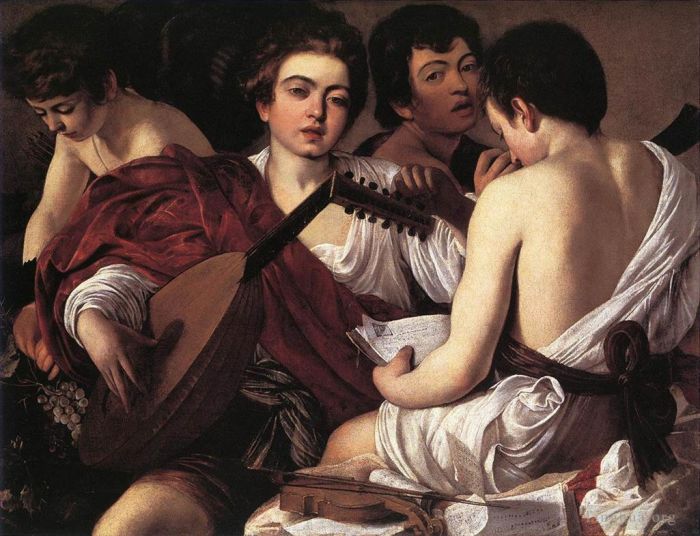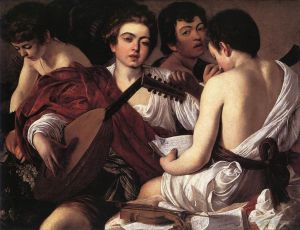The Musicians
Caravaggio
- Price: Price on Request
- Art Type: Oil Painting
- Size:
- English Comments: 0
- International Comments: 0
- Creating Date:
- Introduction and Works of Caravaggio >>
Keywords:
Musicians
Work Overview
- The Musicians
Italian: Concerto di giovani
Artist Caravaggio
Year c. 1595
Medium Oil on canvas
Dimensions 92 cm × 118.5 cm (36 in × 46.7 in)
Location Metropolitan Museum of Art, New York City
The Musicians or Concert of Youths (c. 1595) is a painting by the Italian Baroque master Michelangelo Merisi da Caravaggio (1571–1610). It is held in the Metropolitan Museum of Art, New York, where it has been since 1952. It underwent extensive restoration in 1983.[1]
Caravaggio entered the household of Cardinal Francesco Maria Del Monte sometime in 1595, and The Musicians is thought to have been his first painting done expressly for the cardinal. His biographer, the painter Baglione, says he "painted for the Cardinal youths playing music very well drawn from nature and also a youth playing a lute," the latter presumably being The Lute Player, which seems to form a companion-piece to The Musicians.
The picture shows four boys in quasi-Classical costume, three playing various musical instruments or singing, the fourth dressed as Cupid and reaching towards a bunch of grapes.
Caravaggio seems to have composed the painting from studies of two figures.[2] The central figure with the lute has been identified with Caravaggio's companion Mario Minniti, and the individual next to him and facing the viewer is possibly a self-portrait of the artist.[1] The cupid bears a strong resemblance to the boy in Boy Peeling Fruit, done a few years before, and also to the angel in Saint Francis of Assisi in Ecstasy.
The manuscripts show that the boys are practicing madrigals celebrating love, and the eyes of the lutenist, the principal figure, are moist with tears—the songs presumably describe the sorrow of love rather than its pleasures. The violin in the foreground suggests a fifth participant, implicitly including the viewer in the tableau.[1]
Scenes showing musicians were a popular theme at the time—the Church was supporting a revival of music and new styles and forms were being tried, especially by educated and progressive prelates such as Del Monte. This scene, however, is clearly secular rather than religious, and harks back to the long-established tradition of "concert" pictures, a genre originating in Venice and exemplified, in its earlier form, by Titian's Le concert champêtre.[3]
This was Caravaggio's most ambitious and complex composition to date, and the artist has evidently had difficulties with painting the four figures separately—they don't relate to each other or to the picture-space, and the overall effect is somewhat clumsy. The painting is in poor condition, and the music in the manuscript has been badly damaged by past restorations, although a tenor and an alto part can be made out. Nevertheless, despite considerable paint loss, the work's originality remains undimmed.
Trained in Lombardy, Caravaggio moved to Rome around 1592, and he initially made his reputation with a number of realistic paintings of half-length figures, such as this one. This canvas was painted for his first great patron, Cardinal Francesco del Monte. Although it was described by contemporaries as "una musica" (a music piece), it is an allegory of music. Cupid is shown at left. The costumes have a vaguely classical look and Caravaggio included his self-portrait in the second boy from the right.
Painting Music in the Age of Caravaggio, a small, focused installation that includes three paintings with musical themes—Caravaggio’s The Musicians (1595), Valentin de Boulogne’s The Lute Player (ca. 1626), and Laurent de La Hyre’s Allegory of Music (1649)—along with musical instruments similar to those depicted in the paintings, is on view at The Metropolitan Museum of Art through April 5, 2015. The period during which these pictures were painted witnessed the birth of opera and the promotion of professional singers, rather than amateurs, as solo performers. The period also witnessed the creation of new instruments that challenged the primacy of the lute.
What did people “hear” when they looked at paintings of musical performances? The paintings featured in this exhibition had an intentionally aural, as well as visual, component. The music in Caravaggio’s The Musicians was once legible and would have been chosen by his patron, Cardinal Francesco Maria del Monte, a musical promoter who enjoyed singing accompanied by Spanish guitar and who had a resident male soprano in his service. The music in Laurent de La Hyre’s Allegory of Music includes an exercise for voice, lute tablature for tuning, and a chanson. La Hyre enjoyed singing and must have been pleased with this commission from Gedeon Tallement, a member of the Council of State in Paris who was also a music lover.
The musical instruments on view in Painting Music in the Age of Caravaggio include a lute, theorbo, cornett, bass recorder, flageolet, and violin. The lute was the most popular instrument in Europe for hundreds of years. Derived from the ūd, a Middle Eastern instrument introduced into Europe in the eighth or ninth century, the lute was originally played by striking the strings with a plectrum (similar to a pick). In the 15th century, lutenists began using their fingers, allowing players to perform intricate multipart music. By the 16th century, the lute was a prominent solo instrument and the 17th century saw great changes in musical styles, with singers and violinists becoming the dominant soloists. The lute functioned alongside the viola da gamba and keyboards as part of the accompaniment, and was eventually superseded by the harpsichord.
-----------------------------------------
Another of Caravaggio's early works, painted when he was only twenty-two years old.
The two figures seen frontally are undoubtably portraits, but their identity is unknown. Yet athe fact that they are portraits disappoints those crotocs who would like to make a conventional reading of the scene and concentrate on the noble, classical character of the composition, organized around the traditional opposition between the figure of the lute player and the corresponding figure whom we see from behind.
The face between these two is Caravaggio's; the figure on the left is taken from an earlier composition (Young Peeling a Pear) which we know only from copies.
- Copyright Statement:
All the reproduction of any forms about this work unauthorized by Singing Palette including images, texts and so on will be deemed to be violating the Copyright Laws.
To cite this webpage, please link back here.
- >> English Comments
- >> Chinese Comments
- >> French Comments
- >> German Comments
- >>Report
- Saint Jerome in Meditation
- Still Life with Flowers and Fruit
- The Musicians
- St John the Baptist Youth with Ram
- Supper at Emmaus
- Madonna and Child with St Anne
- Flagellation
- The Sacrifice of Isaac
- Young Sick Bacchus
- Nativity with St Francis and St Lawrence
- Portrait of Alof de Wignacourt1
- St John the Baptist
- The Sacrifice of Isaac2
- The Conversion of St Paul
- David with the Head of Goliath
- The Crucifixion of Saint Peter
- St John the Baptist1
- Narcissus
- Medusa
- Beheading of Saint John the Baptist
- The Martyrdom of St Matthew
- Boy with a Basket of Fruit
- The Denial of St Peter
- Salome with the Head of the Baptist
- Portrait of Alof de Wignacourt2
- St John the Baptist2
- St Francis1
- Saint Jerome Writing (Saint Jerome in His Study or simply Saint Jerome)
- Adoration of the Shepherds
- St Francis2
- Sleeping Cupid
- Saint Jerome Writing
- Christ in the Garden
- Jupiter Neptune and Pluto
- St John the Baptist at the Well
- Portrait of Maffeo Barberini
- The Crucifixion of St Andrew
- David with the head of Goliath
- Portrait of a Courtesan
- The Crowning with Thorns2
- Burial of St Lucy
- St Matthew and the Angel
- Boy Peeling a Fruit
- Ecce Homo
- The Seven Acts of Mercy
- The Entombment
- St Francis in Ecstasy
- The Inspiration of Saint Matthew
- Lute Player
- Judith Beheading Holofernes
- St John the Baptist
- The Incredulity of Saint Thomas
- The Fortune Teller
- The Tooth Drawer
- St Catherine of Alexandria
- Basket of Fruit still life
- David with the Head of Goliath
- The Crowning with Thorns
- Bacchus
- The Calling of Saint Matthew
- Boy Bitten by a Lizard
- The Raising of Lazarus
- Salome with the Head of St John the Baptist
- Magdalene
- The Conversion on the Way to Damascus
- Rest on Flight to Egypt
- The Fortune Teller
- The Lute Player
- The Annunciation
- Taking of Christ
- Amor Victorious
- Madonna di Loreto
- Christ at the Column
- The Death of the Virgin
- The Martyrdom of St Ursula
- Madonna del Rosario
- The Cardsharps
- Supper at Emmaus
- Martha and Mary Magdalene









 Singing Palette
Singing Palette